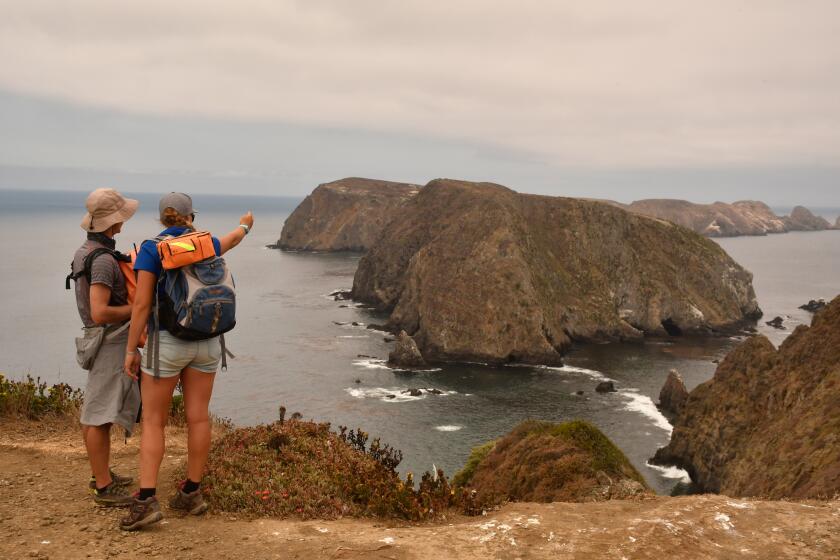‘Polio Pond’ Cure Is Due
- Share via
Doug Stihl figured there was no better spot to teach his daughter how to surf than “the Boneyard” at Doheny State Beach, where the gentle, rolling waves are ideal for beginners, or longboarders like himself.
Stihl, however, made sure to warn Melissa, 14, about the Boneyard’s dark side.
“I told her, ‘No matter what you do, don’t step in that water on the way out to the ocean,’ ” he said.
Known as “Polio Pond” to locals, the stagnant pool of water is less than 100 yards from the shoreline, a polluted brew fed by an urban creek.
“It’s disgusting,” said Stihl, 44, of Laguna Beach.
Dana Point, the county, the state and an environmental group, Miocean, have joined to clean up the pond by filtering the runoff from North Creek and diverting it to a nearby sanitation plant.
The effort is one of several challenges in improving the health of one of Southern California’s most picturesque yet most polluted beaches.
County health officials posted the ocean at Doheny as polluted more than 100 times last year, and the 1.3-mile shoreline has been listed for years as one of the worst beaches in Southern California on Heal the Bay’s annual pollution report card.
Cleaning up the beach and ocean has been a long and costly fight.
Last year, Dana Point began tackling its ocean pollution problem by installing a $750,000 filtration system that collects debris and some pollutants from San Juan Creek, an urban-fed channel that flows to the sea.
This summer, the city will begin a $3-million project to clean up Salt Creek, which empties into the ocean about two miles north of San Juan Creek, near the Laguna Beach border.
North Creek, little more than a flood control channel that slices through the coastal canyons, represents a different problem because the water pools on the beach. The cleanup project will cost about $1.25 million, with $800,000 coming from the city, $350,000 from the State Water Resources Control Board and $100,000 from Miocean, an Irvine-based nonprofit.
The North Creek project, scheduled for completion by August, will filter the runoff before it reaches the sand. Although the material and pollutants strained from the water will be diverted to a sanitation plant, some runoff will continue to pool on the sand. But the resulting pool, health experts said, will be significantly cleaner.
“Water quality is our No. 1 strategic priority,” said Dana Point Councilman Wayne Rayfield. “We’re a beach city, where 40% of our income comes from tourists, so we’re very concerned about health and quality-of-life issues.”
John Moody, a local businessman, became concerned about water quality two years ago when he contracted a staph infection while surfing at Doheny. A short time later, he co-founded Miocean with Keith Ross and talked a group of business leaders into joining.
“We just said enough is enough,” Ross said. “Our goal is to clean up every one of these watersheds.”
The water at Doheny is at its most polluted during storms or high tide. That’s when the flow from San Juan Creek increases, fouling the ocean. North Creek, often providing little more than a trickle, rises during the storms, spewing tainted water onto the sand. At high tide, this water is sometimes pulled into the ocean.
The double-whammy effect is well-known to those who work at the beach.
“It pools around, knocks up against the jetty and there’s not a lot of water movement,” said Bill Pfeiffer, a lifeguard supervisor at Doheny. “That’s when we tell people to swim at their own risk, because there’s bacteria in the water. We always tell them to shower off after swimming and not to go in the water with open wounds.”
No warning signs have been posted lately at Doheny, thanks mostly to a recent spell of dry weather. But Polio Pond is another matter. It’s always posted.
The warning signs are simple but pointed: “Warning: Contaminated Water. Urban Runoff/Storm Drain Water May Cause Illness.”
On an unusually balmy afternoon last week, most beachgoers were taking note of the signs, avoiding contact with the pool of foul, mucky water as they tiptoed across a makeshift bridge of two 2-by-4s on their way to the beach.
But not everybody is so careful.
“In the summer, the kids going to Orange County day camp here wade through it after getting dropped off by their parents,” Rayfield said. “Those that didn’t wade through it probably stopped and played in it.”
The pond has been around for more than 30 years. And as the population of Dana Point grew, Polio Pond turned darker and thicker, with more biotic material flowing from storm drains.
Most locals, however, have learned to live with Doheny’s pollution problems.
“I love to surf here, and usually I just keep my mouth closed when I catch a wave,” Stihl said. “I know I’m pushing my luck, though.”
More to Read
Sign up for Essential California
The most important California stories and recommendations in your inbox every morning.
You may occasionally receive promotional content from the Los Angeles Times.













